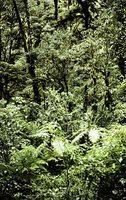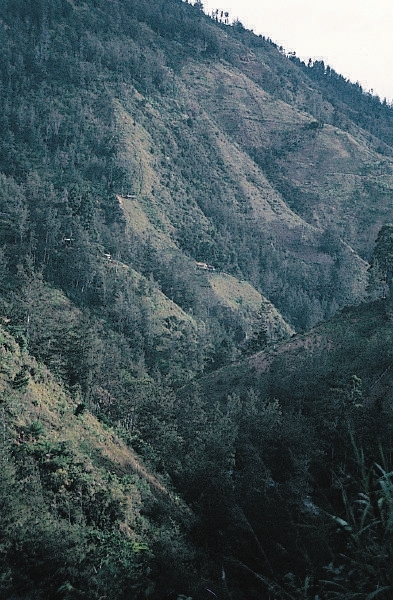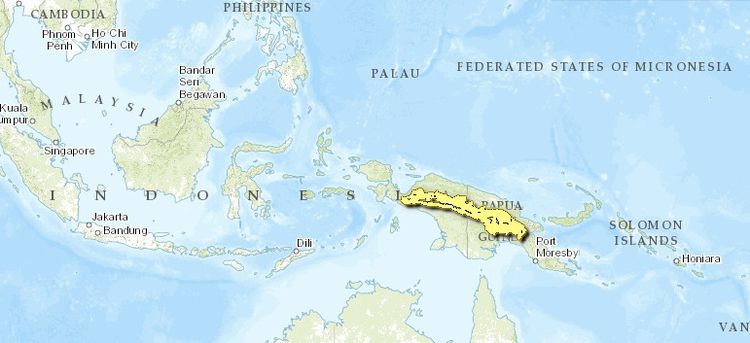Central Range montane rain forests
Location and General Description
 Nothofagus forest, Irian Jaya, Indonesia. (Photograph by © WWF-Canon/John Ratcliffe)
Nothofagus forest, Irian Jaya, Indonesia. (Photograph by © WWF-Canon/John Ratcliffe) This ecoregion is made up of the montane forests between 1,000 meters and 3,000 meters in the Central Cordillera of the island of New Guinea, in Irian Jaya, Indonesia and PNG, in the western Pacific Ocean north of Australia. The Central Cordillera is composed of a series of mountain ranges that are broadly grouped into the Snow Mountains in Irian Jaya, the Star Mountains in Irian Jaya and PNG, and the Central and Eastern Highlands in PNG. The climate of the ecoregion is tropical highland wet because of its elevation. The surface geology of the Central Cordillera is composed of metamorphic and intrusive igneous rocks. The metamorphic rocks were Cretaceous (100 m.y.) and Eocene (40 m.y.) ocean sediments that were folded between the Eocene and early Miocene Periods (20 m.y.). Pleistocene stratovolcanoes are also found in the Central Ranges.
There are three broad vegetation zones in the Central Ranges: lower montane forest, upper montane forest, and high mountain forest (although these are sometimes lumped into one lower montane rain forest). Lower montane forest continues up from the lowlands to approximately 2,500 meters. This zone is dominated by oaks, such as Castanopsis acuminatissima, elaeocarps, and laurels. Araucaria may form thick stands in lower areas. Nothofagus, sometimes in monotypic stands, is conspicuous in the moss-covered upper montane forest, which begins at about 1,500 meters. High mountain forest begins at approximately 2,500 meters and continues past the upper limits of the ecoregion, to 3,900 meters. The species-poor, high mountain forest includes conifers (Podocarpus, Dacrycarpus, Dacridium, Papuacedrus, Araucaria, and Libocedrus) and Myrtacae, with a thin canopy and prominent understory.
Biodiversity Features
The overall richness of this ecoregion is remarkable and ranges from moderate to high. The ecoregion contains some of the highest richness of vascular plants and herpetofauna in Indo-Malaysia and some of the highest endemism for mammals, birds, and vascular plants.
The mammalian fauna consists of a wide variety of tropical Australasian marsupials, including tree kangaroos. Ninety mammal species inhabit this ecoregion, of which an incredible forty-four are endemic or near endemic (Table 1). Four of these species are considered critically endangered: Bulmer's fruit-bat (Aproteles bulmerae), large leptomys (Leptomys elegans), eastern shrew-mouse (Pseudohydromys murinus), and lesser small-toothed rat (Macruromys elegans).
|
Table 1. Endemic and Near-Endemic Mammal Species. Family Species Dasyuridae Neophascogale lorentzi* Dasyuridae Phascolosorex doriae Dasyuridae Antechinus wilhelmina Phalangeridae Phalanger vestitus* Phalangeridae Phalanger matanim* Macropodidae Dorcopsulus macleayi Pseudocheiridae Pseudocheirus caroli* Pseudocheiridae Pseudocheirus mayeri* Petauridae Dactylopsila megalura* Peroryctidae Microperoryctes murina Peroryctidae Echymipera clara Pteropodidae Aproteles bulmerae Pteropodidae Syconycteris hobbit Emballonuridae Emballonura furax Rhinolophidae Hipposideros corynophyll* Rhinolophidae Hipposideros muscinus Vespertilionidae Pipistrellus collinus Vespertilionidae Nyctophilus microdon* Vespertilionidae Kerivoula muscina Molossidae Otomops secundus Muridae Leptomys elegans Muridae Paraleptomys wilhelmina* Muridae Neohydromys fuscus Muridae Pseudohydromys murinus Muridae Mayermys ellermani Muridae Hydromys hussoni Muridae Hydromys habbema* Muridae Crossomys moncktoni Muridae Macruromys elegans* Muridae Xenuromys barbatus Muridae Melomys fellowsi* Muridae Melomys lorentzi Muridae Melomys lanosus* Muridae Pogonomelomys mayeri Muridae Pogonomelomys bruijni Muridae Abeomelomys sevia Muridae Coccymys albidens* Muridae Rattus giluwensis* Muridae Rattus novaeguineae Muridae Hyomys dammermani Muridae Hydromys shawmayeri Muridae Leptomys ernstmayeri Muridae Melomys gracilis Muridae Pogonomys championi* An asterisk signifies that the species' range is limited to this ecoregion. Table 2. Endemic and Near-Endemic Bird Species. Family Common Name Species Rallidae Chestnut forest-rail Rallina rubra Loriidae Orange-billed lorikeet Neopsittacus pullicauda Loriidae Striated lorikeet Charmosyna multistriata Psittacidae Painted tiger-parrot Psittacella picta Psittacidae Madarasz's tiger-parrot Psittacella madaraszi Psittacidae Modest tiger-parrot Psittacella modesta Aegothelidae Archbold's owlet-nightjar Aegotheles archboldi Caprimulgidae Mountain eared-nightjar Eurostopodus archboldi Apodidae Bare-legged swiftlet Aerodramus nuditarsus Apodidae Papuan swiftlet Aerodramus papuensis Campephagidae Hooded cuckoo-shrike Coracina longicauda Acanthizidae Papuan thornbill Acanthiza murina Cinclosomatidae Blue-capped ifrita Ifrita kowaldi Cinclosomatidae Papuan whipbird Androphobus viridis* Melanocharitidae Streaked berrypecker Melanocharis striativentris Eopsaltriidae White-winged robin Peneothello sigillatus Eopsaltriidae Green-backed robin Pachycephalopsis hattamensis Eopsaltriidae Greater ground-robin Amalocichla sclateriana Eopsaltriidae Alpine robin Petroica bivittata Eopsaltriidae Smoky robin Peneothello cryptoleucus Pachycephalidae Sooty shrike-thrush Colluricincla umbrina* Pachycephalidae Lorentz's whistler Pachycephala lorentzi Pachycephalidae Wattled ploughbill Eulacestoma nigropectus Pachycephalidae Black sittella Daphoenositta miranda Climacteridae Papuan treecreeper Cormobates placens Meliphagidae Orange-cheeked honeyeater Oreornis chrysogenys Meliphagidae Leaden honeyeater Ptiloprora plumbea Meliphagidae Rufous-sided honeyeater Ptiloprora erythropleura Meliphagidae Black-backed honeyeater Ptiloprora perstriata Meliphagidae Spot-breasted meliphaga Meliphaga mimikae Meliphagidae Olive-streaked honeyeater Ptiloprora meekiana Meliphagidae Yellow-browed honeyeater Melidectes rufocrissalis Meliphagidae Sooty honeyeater Melidectes fuscus Meliphagidae Belford's honeyeater Melidectes belfordi Meliphagidae Rufous-backed honeyeater Ptiloprora guisei Meliphagidae Cinnamon-browed honeyeater Melidectes ochromelas Estrildidae Snow Mountain munia Lonchura montana* Estrildidae Black-breasted munia Lonchura teerinki* Estrildidae Mountain firetail Oreostruthus fuliginosus Ptilonorhynchidae Archbold's bowerbird Archboldia papuensis* Paradisaeidae Short-tailed paradigalla Paradigalla brevicauda* Paradisaeidae King-of-Saxony bird-of-paradise Pteridophora alberti* Paradisaeidae Yellow-breasted bird-of-paradise Loboparadisea sericea Paradisaeidae Loria's bird-of-paradise Cnemophilus loriae Paradisaeidae Long-tailed paradigalla Paradigalla carunculata Paradisaeidae Carola's parotia Parotia carolae Paradisaeidae Lawes's parotia Parotia lawesii Paradisaeidae Splendid astrapia Astrapia splendidissima Paradisaeidae Ribbon-tailed astrapia Astrapia mayeri Paradisaeidae Blue bird-of-paradise Paradisaea rudolphi Paradisaeidae Crested bird-of-paradise Cnemophilus macgregorii Paradisaeidae MacGregor's bird-of-paradise Macgregoria pulchra Paradisaeidae Brown sicklebill Epimachus meyeri Paradisaeidae Princess Stephanie's astrapia Astrapia stephaniae Paradisaeidae Greater melampitta Melampitta gigantea An asterisk signifies that the species' range is limited to this ecoregion. The avifauna of the ecoregion (Central Range montane rain forests) has a clear Australasian flavor, including representatives of several Australasian families such as Ptilonorhynchidae, Eopsaltridae, Meliphagidae, and Paradisaeidae. The ecoregion harbors 348 bird species, of which 55 are endemic or near endemic (Table 2). This ecoregion forms the majority of the Central Papuan mountains EBA, which contains fifty-three restricted-range bird species, eight of which are found in the adjacent Central Range sub-alpine grasslands, thirteen of which are shared with the adjacent Central Range sub-alpine grasslands, and seventeen of which are found nowhere else on Earth. Four of these species represent endemic genera. Archbold's bowerbird (Archboldia papuensis), ribbon-tailed astrapia (Astrapia mayeri), and the blue bird-of-paradise (Paradisaea rudolphi) are considered vulnerable. Within this ecoregion, the Weyland Range (with nine endemic species) and the Hagen-Sepik-Wahgi Divide (with five endemic species) are both centers of butterfly endemism on the island of New Guinea. Seven Centres of Plant Diversity are shared between this ecoregion and the adjacent Central Ranges sub-alpine grassland ecoregion. The Star Mountains-Telefomin-Tifalmin-Strickland Gorge CPD in PNG contains very rich (more than 3,000 vascular plant species) montane and high-altitude vegetation. The Hunstein Range-Bürgers Mountain-Schatteburg, Mt. Giluwe-Tari Gap-Doma Peaks CPD in PNG contains more than 2,500 vascular plant species and extensive stands of Agathis labillardieri and associated epiphytic flora. More than 3,000 vascular plant species are found in the Mt. Giluwe-Tari Gap-Doma Peaks CPD in PNG, including a unique Dacrydium swamp forest. The poorly known Kubor Ranges in PNG are a fragile ecosystem that probably contains many endemics on limestone and volcanic ash. The Bismarck Falls-Mt. Wilhelm-Mt. Otto-Schrader Range-Mt. Hellwig-Gahavisuka CPD has a wide variety of vegetation types and contains more than 5,000 vascular plant species. Important Araucaria cunninghamii, A. hunsteinii, and Castanopsis forests are found in the Mt. Michael-Okapa-Crater Mountain CPDs in PNG. Current StatusThe montane rain forests are generally undisturbed because of low population densities and traditional lifestyles. Some highland valleys are heavily populated, and this has resulted in local deforestation. A large and well-known hardrock mine is found in this ecoregion: the Freeport copper mine, located within the Lorentz Strict Nature Reserve in Irian Jaya. This is a large facility, and its location in a pristine area has caused concern about sedimentation and toxic runoff into adjacent stream and river systems. Petroleum extraction also occurs in Southern Highlands Province in PNG, but the environmental effects are minimal. More than half of the Lorentz Nature Reserve is under petroleum concessions. Almost 20 percent of the ecoregion is covered by eleven protected areas (Table 3). The bulk of the protected area is in Irian Jaya, however. The largest protected area in the Central Ranges is the 21,500 km2 Gunung Lorentz Nature Reserve in the Snow Mountains of Irian Jaya, although only 7,350 km2 of the area is in this ecoregion.
| |||||

